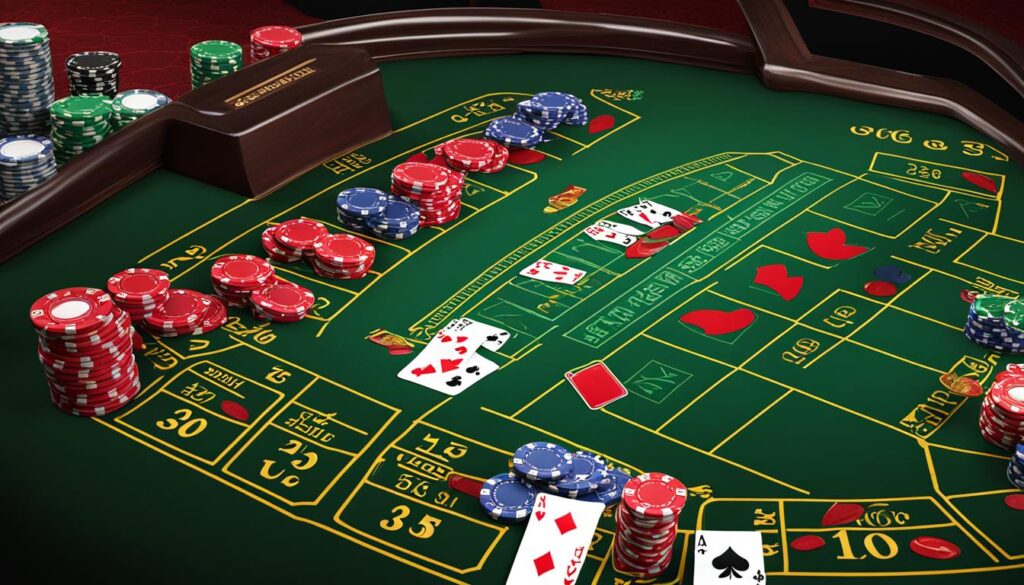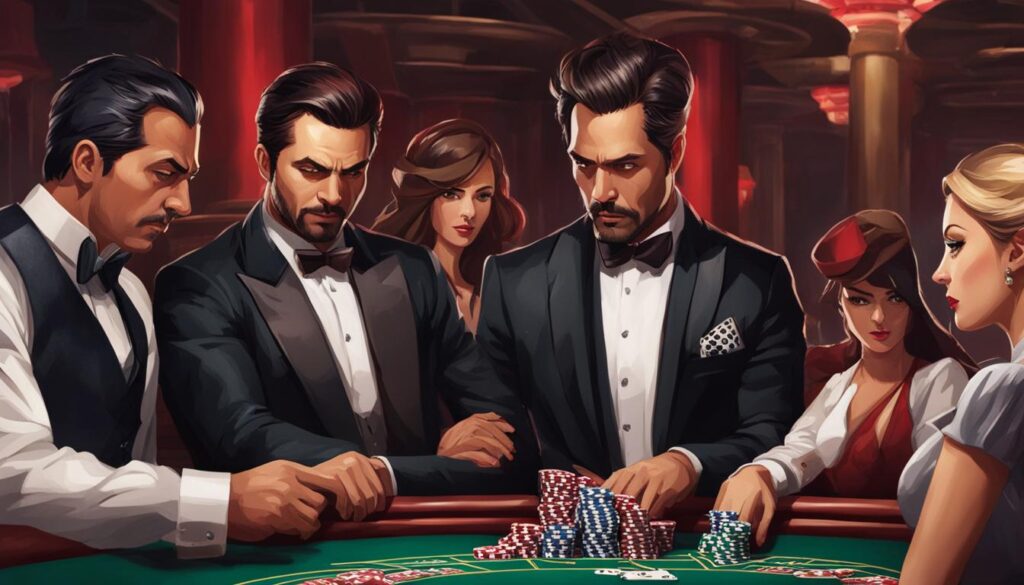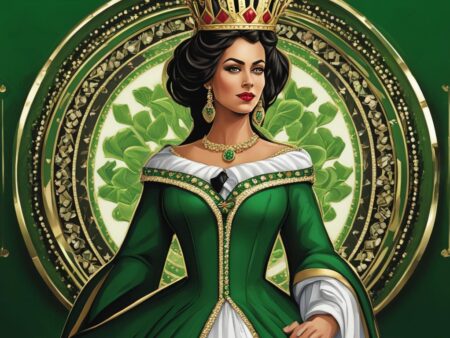Welcome to our essential guide on dealer bust cards in blackjack. In this article, we will delve into the concept of dealer bust cards and their significance in the game of blackjack. If you’ve ever wondered what factors influence the dealer’s chances of busting and how you can leverage this knowledge to improve your own strategy, you’re in the right place. So, let’s explore the world of dealer bust cards in blackjack and gain a deeper understanding of this key aspect of the game.
Key Takeaways:
- Dealer bust cards in blackjack are the cards that have a higher probability of causing the dealer to exceed a total of 21 and result in a bust for them.
- Knowing which cards are dealer bust cards can help players make strategic decisions and improve their odds of winning.
- The worst cards for the dealer are 5 and 6, which have the highest chances of causing a bust.
- The best cards for the dealer are Ace, 10, and 9, which have the lowest chances of resulting in a bust.
- Understanding dealer bust cards is just one aspect of overall blackjack strategy, which also considers other factors like the player’s hand and the composition of the remaining cards in the deck.
The Worst Cards for the Dealer – 5 and 6
In blackjack, certain cards have a higher probability of causing the dealer to exceed a total of 21, resulting in a bust for them. These cards are known as “bust cards” for the dealer. Among them, the worst cards for the dealer are the 5 and 6. According to data analysis, the dealer has a 42 percent chance of busting when showing a 5 or 6, closely followed by a 40 percent chance with a 4.
Knowing the dealer’s bust cards can be advantageous for players. When the dealer’s up card is a 4, 5, or 6, players are advised to consider doubling down more often. This strategy can increase the player’s potential winnings. However, it’s important to note that these bust card probabilities are just one aspect of overall blackjack strategy. Players should still consult basic strategy charts and consider other factors before making their decisions.
The Worst Cards for the Dealer – 5 and 6
| Dealer’s Up Card | Bust Percentage |
|---|---|
| 5 | 42% |
| 6 | 42% |
| 4 | 40% |
By understanding the probabilities associated with dealer bust cards, players can make more informed decisions and improve their odds of winning in blackjack.
The Best Cards for the Dealer – Ace, 10, and 9
When it comes to dealer bust cards in blackjack, there are certain cards that pose less risk for the dealer. The best cards for the dealer are Ace, 10, and 9. These cards have the lowest chances of causing the dealer to bust, meaning that the dealer is less likely to exceed a total of 21.
When the dealer’s up card is an Ace, 10, or 9, the house gains an advantage because the player has to act first. According to basic strategy, if a player has a hand of less than 17, they are advised to take a hit when the dealer’s up card is a 7, 8, 9, 10, or Ace. This is because if the player busts, they lose the hand even if the dealer also busts. Therefore, the house’s chances of winning are greater than just the bust percentages shown in the chart.
| Dealer’s Up Card | Bust Percentage |
|---|---|
| Ace | 17% |
| 10 | 21% |
| 9 | 23% |
While these cards are considered the best for the dealer, it’s important to note that the dealer’s bust percentage is not predictable in any specific hand, as it depends on the unknown cards in the deck. Other factors, such as the player’s own hand and the composition of the deck, should also be considered when making strategic decisions in blackjack.
By understanding the concept of dealer bust cards and considering all relevant factors, players can develop a comprehensive blackjack strategy that maximizes their chances of winning.
How Dealer Bust Cards Impact Strategy Decisions
Understanding the dealer’s bust percentage based on their up card can guide players in making optimal strategy decisions. By knowing which cards are more likely to result in a dealer bust, players can adjust their gameplay accordingly. When the dealer shows a card that has a higher probability of causing a bust, players can choose to stand on a hand totaling 12 to 21 to minimize the risk of going over 21 and losing the hand.
Conversely, when the dealer’s up card indicates a lower likelihood of busting, players may choose to be more aggressive and take additional cards to improve their hands. This strategy can be especially beneficial when the player’s hand is below 17, as they can aim to reach a higher hand total and potentially beat the dealer’s hand. However, it is important to note that these decisions should still be made in accordance with basic strategy guidelines to optimize overall gameplay.
How to Make Strategy Decisions Based on Dealer Bust Cards
Here are a few key considerations when incorporating dealer bust cards into your blackjack strategy:
- Know the likelihood of the dealer busting based on their up card. The worst cards for the dealer are 5 and 6, which have a higher probability of leading to a bust. Conversely, the best cards for the dealer are Ace, 10, and 9, which have the lowest chances of resulting in a bust.
- Adjust your decisions based on the dealer’s probability of busting. When the dealer has a higher chance of busting, consider standing on a hand totaling 12 to 21. When the dealer has a lower chance of busting, you may choose to be more aggressive and take additional cards.
- Remember to balance dealer bust card probabilities with other factors such as your own hand, the composition of the remaining cards in the deck, and the specific rules of the blackjack variant being played.
By incorporating the concept of dealer bust cards into your blackjack strategy, you can make more informed decisions that increase your chances of winning. However, it is important to remember that blackjack is ultimately a game of chance, and no strategy can guarantee consistent winnings. It is crucial to approach the game responsibly and enjoy the excitement it offers. Understanding dealer bust cards is just one aspect of a comprehensive blackjack strategy.
The Importance of Basic Strategy in Avoiding Dealer Bust Cards
When it comes to playing blackjack, understanding basic strategy is essential in avoiding dealer bust cards and increasing your chances of winning. Basic strategy provides a set of optimal moves based on mathematical calculations and simulations. By following this strategy, you can make informed decisions that minimize the risk of going over 21 and losing the hand.
One of the key aspects of basic strategy is considering the dealer’s up card. Knowing which cards are likely to result in a dealer bust can guide your gameplay. For example, when the dealer’s up card is a 5 or a 6, they have a high probability of busting. In such cases, it’s advisable to stand on a hand totaling 12 to 21, rather than risking going over 21 by taking additional cards.
However, it’s important to note that basic strategy should be used as a confirmation rather than the sole basis for your decisions. Other factors, such as the composition of the remaining cards in the deck and your own hand, should also be taken into account. Basic strategy charts are a valuable tool that can help you make the right moves based on the dealer’s up card and your hand. By memorizing or using a chart during gameplay, you can consistently make decisions that statistically optimize your chances of winning.
The Importance of Basic Strategy in Avoiding Dealer Bust Cards
Using basic strategy is crucial in avoiding dealer bust cards and improving your odds in blackjack. By considering the dealer’s up card and making informed decisions based on basic strategy, you can minimize the risk of going over 21 and losing the hand. Remember to also take into account other factors such as the remaining cards and your own hand, and use basic strategy charts as a valuable reference during gameplay.
Understanding Dealer Bust Cards in Blackjack and Blackjack Odds
When playing blackjack, it is important to understand the concept of dealer bust cards and how they can impact the odds of the game. Dealer bust cards are the up cards that have a higher probability of causing the dealer to exceed a total of 21, resulting in a bust for them. By knowing which cards are more likely to result in a dealer bust, players can make strategic decisions to improve their chances of winning.
The probability of the dealer busting varies depending on their up card. According to data analysis, the dealer has the highest chances of busting when their up card is a 5 or a 6, with a 42 percent chance in both cases. This is closely followed by a 40 percent chance when the up card is a 4. On the other hand, the dealer has the lowest chances of busting when their up card is an Ace, 10, or 9.
It is important to consider the dealer’s bust percentage based on their up card when making strategy decisions. For example, when the dealer shows a card that is likely to result in a bust, players can choose to stand on a hand totaling 12 to 21 to minimize the risk of going over 21 and losing the hand. On the other hand, when the dealer’s up card indicates a lower likelihood of busting, players may choose to be more aggressive and take additional cards to improve their hands. It is crucial to remember that these decisions should still be made in accordance with basic strategy guidelines to optimize overall gameplay.
Factors Beyond Dealer Bust Cards
While knowing the dealer’s bust cards is valuable information, it is crucial to consider other factors as well. The player’s own hand, the composition of the remaining cards in the deck, and the specific rules of the blackjack variant being played all influence strategic decisions. Players should also be aware that the dealer’s bust percentage is not predictable in any specific hand, as it depends on the unknown cards in the deck. Therefore, relying solely on the dealer’s bust cards without considering these other factors may not lead to optimal gameplay.
When playing blackjack, it’s important to assess the overall context of the game, not just the dealer’s up card. The player’s hand strength, the current count of high and low cards, and the specific rules of the game all play a role in making informed decisions. For example, if a player has a weak hand but the dealer’s up card is a bust card, it may still be advisable to hit rather than stand. Conversely, if the dealer’s up card is favorable but the player has a strong hand, it may be wise to stand and let the dealer take the risk of busting.
Additionally, the number of players at the table can also impact gameplay. The more players there are, the more likely it is that the dealer will bust. This is because with more players, there is a higher chance that the remaining cards will be dealt out before the dealer’s turn, increasing the likelihood of them going over 21. Conversely, if there are fewer players at the table, the dealer’s chances of busting are reduced. Therefore, it’s important to consider the overall game dynamics and adjust strategy accordingly.
In summary, while understanding the dealer’s bust cards is important, it’s just one piece of the blackjack strategy puzzle. To maximize your chances of winning, it’s crucial to consider other factors such as your own hand, the composition of the deck, the specific rules of the game, and the number of players at the table. By taking a holistic approach to your strategy and considering all relevant factors, you can make more informed decisions and increase your odds of success in blackjack.
The Relationship Between Decks in Play and House Edge
One important factor that influences the house edge in blackjack is the number of decks used in the game. The number of decks can significantly impact the odds of winning for both the player and the dealer. Generally, a lower number of decks results in a lower house edge, giving players a better chance of winning. On the other hand, a higher number of decks increases the house edge, making it more difficult for players to come out on top.
When playing with one deck, the house edge is typically around 0.17 percent, which is considered to be very low. This means that players have a higher likelihood of winning when fewer decks are in play. As the number of decks increases, the house edge also increases. For example, a game played with six decks can have a house edge of around 0.65 percent.
While it may seem like a small difference, the impact of the number of decks on the house edge can have a significant effect on a player’s overall winnings in the long run. Therefore, players looking to maximize their chances of winning should seek out games with fewer decks in play. However, it’s important to note that other rules and variations of the game may change depending on the number of decks, so players should familiarize themselves with the specific rules before choosing a game.
| Number of Decks | House Edge |
|---|---|
| 1 | 0.17% |
| 2 | 0.46% |
| 4 | 0.60% |
| 6 | 0.65% |
As shown in the table above, the house edge gradually increases as the number of decks increases. This information can be valuable for players who are looking to maximize their chances of winning in blackjack. However, it’s important to remember that the number of decks is just one factor to consider when developing a winning strategy. Players should also take into account other factors, such as basic strategy, bankroll management, and their own personal skills and experiences.
Using Blackjack Strategy Charts

One of the most valuable tools for players looking to optimize their gameplay in blackjack is the use of strategy charts. These charts provide players with the best mathematical moves based on their own hand and the dealer’s up card. By finding the intersection of their hand on the vertical axis and the dealer’s up card on the horizontal axis, players can easily identify the recommended action. Strategy charts indicate whether to hit, stand, split, or double down, ensuring that players consistently make decisions that statistically maximize their chances of winning.
“Strategy charts are invaluable resources for players who want to make optimal decisions in blackjack. By following these charts, players can have confidence that they are using the best possible strategy for any given situation. It takes the guesswork out of the game and helps players make informed decisions based on the probabilities and expected outcomes.”
Using a strategy chart is also advantageous because it simplifies the decision-making process, especially for novice players. Rather than relying solely on intuition or guesswork, players can rely on the proven strategies outlined in the chart. This helps players avoid costly mistakes and maximizes their chances of winning. It is important to note that strategy charts are based on mathematical calculations and simulations, which have identified the most optimal moves in different scenarios. Therefore, using these charts can significantly improve a player’s odds of success in blackjack.
While strategy charts are powerful tools, it is essential to remember that they are not a guarantee of winning. Blackjack is ultimately a game of chance, and there is always a house edge. Strategy charts, however, allow players to minimize the house edge and optimize their overall gameplay. By consistently using strategy charts, players can enhance their decision-making skills and increase their chances of winning in the long run.
Example of a Blackjack Strategy Chart
| Player’s Hand | Dealer’s Up Card | Recommended Action |
|---|---|---|
| Hard 5 to 8 | Any | Hit |
| Hard 9 | 2 to 6 | Double Down |
| Hard 9 | 7 to Ace | Hit |
| Hard 10 or 11 | Any | Double Down |
| Hard 12 to 16 | 2 to 6 | Stand |
| Hard 12 to 16 | 7 to Ace | Hit |
| Hard 17 to 21 | Any | Stand |
| Soft 13 to 15 | Any | Hit |
| Soft 16 to 18 | 2 to 6 | Double Down |
| Soft 16 to 18 | 7 to Ace | Hit |
| Soft 19 to 21 | Any | Stand |
| Pairs | Any | Refer to Splitting Strategy |
Example of a Blackjack Strategy Chart
Using a blackjack strategy chart can be an effective tool for players looking to maximize their chances of winning. These charts provide a visual representation of the best moves based on the player’s hand and the dealer’s up card. By referencing the chart, players can quickly determine whether to hit, stand, split, or double down.
Below is an example of a blackjack strategy chart:
| Player’s Hand | Dealer’s Up Card | Recommended Action |
|---|---|---|
| Hard 8 or less | Any card | Hit |
| Hard 9 | 2-6 | Double Down |
| Hard 9 | 7-8, Ace | Hit |
| Hard 10 | 2-9 | Double Down |
| Hard 10 | 10, Ace | Hit |
| Soft 13-14 | 5-6 | Double Down |
| Soft 13-14 | 7-8, Ace | Hit |
| Soft 15-16 | 4-6 | Double Down |
| Soft 15-16 | 7-8, Ace | Hit |
| Soft 17-18 | 3-6 | Double Down |
| Soft 17-18 | 7-8, Ace | Hit |
| Pairs | 2-7 | Split |
| Pairs | 8, Ace | Split or Double Down |
| Pairs | 9 | Split |
| Pairs | 10 | Stand |
It is important to note that the example strategy chart provided is for general reference and may vary depending on the specific blackjack variant being played. Additionally, the strategy chart is based on mathematical probabilities and calculations, but there is still an element of chance in the game. Players should use the chart as a guide and consider other factors, such as their own hand and the composition of the remaining cards, when making decisions.
By using a blackjack strategy chart and incorporating it into their gameplay, players can increase their chances of making optimal decisions and improving their overall blackjack strategy.
The Importance of Card Counting
When it comes to gaining an edge over the casino in blackjack, card counting is a technique that some skilled players employ. Card counting involves keeping track of the ratio of high cards to low cards remaining in the deck. By doing so, players can gain insight into the likelihood of getting a strong hand or a blackjack. Card counting allows players to make more informed decisions based on the remaining cards in play, giving them an advantage over the house.
However, it is important to note that while card counting can be an effective strategy, it is not allowed in many casinos and can result in being banned if detected. Casinos are constantly on the lookout for card counters and employ various measures, such as using multiple decks or implementing stricter rules, to counteract this technique. Therefore, players should exercise caution and consider the potential consequences before attempting card counting.
“Card counting is a powerful tool that can give players a significant edge in blackjack. However, it requires practice, focus, and a deep understanding of the game. It’s not for everyone, but for those willing to put in the effort, it can be a game-changer.” – Professional Blackjack Player
It is worth noting that card counting is not a guaranteed path to success in blackjack. While it can provide players with an advantage, it does not guarantee consistent winnings. The outcome of any individual hand is still subject to chance, and the house always maintains a mathematical edge. Card counting should be approached as a supplemental strategy rather than the sole basis for gameplay. Players should also be aware of the potential legal implications before venturing into card counting.
| Advantages of Card Counting | Disadvantages of Card Counting |
|---|---|
|
|
Ultimately, card counting can be a powerful tool in the hands of skilled players. It allows them to make more informed decisions and potentially gain an edge over the casino. However, it is important to approach card counting responsibly and be aware of the potential consequences. By combining card counting with other blackjack strategies, such as basic strategy and effective bankroll management, players can enhance their chances of success in the game of blackjack.
Other Blackjack Strategies

When it comes to blackjack strategy, there are a few other approaches that players can consider alongside basic strategy and card counting. These strategies may offer alternative ways to approach the game and potentially improve your chances of winning. While they don’t guarantee consistent winnings, they can add an extra layer of excitement to your gameplay. Let’s explore some of these strategies:
1. Progressive Betting Systems
Progressive betting systems involve adjusting your bet size based on the outcome of the previous hand. One example is the Martingale system, where you double your bet after a loss and revert to your original bet after a win. This system aims to recoup losses and potentially make a profit. However, it’s important to note that progressive betting systems can be risky and may require a substantial bankroll.
2. Card Clumping
Card clumping is a strategy that involves tracking certain cards or groups of cards as they are played. This can help players make more informed decisions based on the cards that are likely to come up next. However, card clumping requires a keen eye and a good memory, as well as practice to effectively implement this strategy.
3. Shuffle Tracking
Shuffle tracking is a more advanced strategy that involves predicting the location of certain cards in the shuffled deck. By observing the shuffling process and memorizing the patterns, players can gain an advantage by knowing which cards are likely to be dealt next. However, shuffle tracking is difficult to master and may not be feasible in all playing conditions.
“Keep in mind that these alternative strategies are not foolproof and may not work in every situation. To succeed in blackjack, it’s important to combine strategy with a solid understanding of the game and disciplined bankroll management.”
Remember, while these strategies can be intriguing, they should be approached with caution. Blackjack is ultimately a game of chance, and the house always maintains a mathematical advantage. Responsible gambling and enjoyment of the game should always take precedence over any strategy.
Importance of Practice and Experience
Developing skill in blackjack requires practice and experience. While understanding the dealer’s bust cards and employing basic strategy are important foundations, they can only take a player so far. It is through firsthand experience and repeated play that players can truly refine their decision-making skills and ability to read the game. Practice allows players to become more comfortable with the nuances of the game and adapt to different scenarios. By continuously honing their skills, players can improve their chances of success in blackjack.
Practice not only helps players become more familiar with the rules and mechanics of the game, but it also allows them to develop a sense of timing and intuition. Through practice, players can begin to recognize patterns and tendencies in the way the cards are dealt. This can be particularly valuable when it comes to making strategic decisions, such as when to hit, stand, split, or double down.
Experience, on the other hand, provides players with a broader perspective and a deeper understanding of the game. As players gain more experience, they become more adept at reading their opponents and anticipating their moves. This can give players a significant advantage at the blackjack table, as they will be better equipped to make informed decisions based on the current situation.
| Practice | Experience |
|---|---|
| Develop skills and decision-making abilities | Gain a broader perspective and deeper understanding |
| Become familiar with rules and mechanics | Read opponents and anticipate their moves |
| Recognize patterns and tendencies in card dealing | Make informed decisions based on current situation |
Both practice and experience are essential for success in blackjack. They complement each other, allowing players to continually improve and adapt their gameplay. By dedicating time to practice and actively seeking out opportunities to gain experience, players can enhance their skills and increase their chances of winning in the exciting game of blackjack.
Managing Bankroll and Setting Limits
Effective bankroll management is crucial for any gambler. In blackjack, it is important to set limits on how much one is willing to bet and to avoid chasing losses. Players should establish a budget for each session and stick to it, regardless of the outcome. This helps ensure responsible and enjoyable gambling experience. It’s important to remember that gambling should be seen as entertainment, not as a way to make money. By setting win and loss limits, players can protect themselves from excessive losses or impulsive gambling behavior.
One effective way to manage bankroll is the 5% rule. This rule suggests that players should not bet more than 5% of their total bankroll on a single hand. For example, if a player has $100, the maximum bet per hand should be $5. This rule helps prevent significant losses in case of a losing streak. It’s also advisable to divide the bankroll into smaller units or sessions to avoid spending the entire budget too quickly.
Additionally, players should avoid the temptation to chase losses. It can be tempting to increase bets after a losing hand in an attempt to recoup losses quickly. However, this can lead to even greater losses. Sticking to the predetermined budget and bet sizes prevents impulsive and emotional decision-making. It’s important to approach blackjack with a calm and strategic mindset.
Overall, effective bankroll management helps players maintain control over their gambling activities and ensures a responsible and enjoyable experience. Setting limits on bets, avoiding chasing losses, and treating gambling as entertainment rather than a source of income are key principles to follow. By adopting these practices, players can maximize their enjoyment while minimizing the risks associated with gambling.
Example of Bankroll Management and Limits:
| Bankroll | Max Bet (5%) | Win Limit (50%) | Loss Limit (50%) |
|---|---|---|---|
| $200 | $10 | $100 | $100 |
| $500 | $25 | $250 | $250 |
| $1000 | $50 | $500 | $500 |
The Excitement of Blackjack
When it comes to casino games, few can match the excitement and thrill of blackjack. The combination of strategy, skill, and luck makes each hand a suspenseful experience. And one important element that adds to the strategic depth of the game is understanding dealer bust cards. Knowing what cards are more likely to lead to a dealer’s bust can give players an edge, allowing them to make informed decisions to improve their odds of winning.
Dealer bust cards refer to the cards that increase the chances of the dealer going over 21, resulting in a bust. By understanding which cards fall into this category, players can make strategic choices to maximize their potential winnings. For example, when the dealer’s up card is a 5 or a 6, they have a higher probability of busting. This knowledge can influence a player’s decision to double down or stand on their hand, depending on their own cards.
However, it’s important to note that understanding dealer bust cards is just one aspect of blackjack strategy. Players should also consider other factors, such as their own hand and the composition of the remaining cards in the deck. Additionally, utilizing a basic strategy chart can provide a comprehensive guide to making optimal decisions based on the dealer’s up card and the player’s hand.
Example of a Blackjack Strategy Chart:
| Player’s Hand | Dealer’s Up Card | Recommended Action |
|---|---|---|
| Hard Total 8 or less | 2-9 | Hit |
| Hard Total 9 | 2-6 | Double Down |
| Hard Total 9 | 7-Ace | Hit |
| Hard Total 10 | 2-9 | Double Down |
| Hard Total 10 | 10-Ace | Hit |
| Hard Total 11 | 2-Ace | Double Down |
| Soft Total 13-14 | 5-6 | Double Down |
| Soft Total 15-16 | 4-6 | Double Down |
| Soft Total 17 | 3-6 | Double Down |
| Soft Total 18 | 2-6 | Double Down |
| Pair of Aces or 8s | 2-9 | Split |
| Pair of Aces | 10-Ace | Hit |
| Pair of 10s | 2-9 | Stand |
| Pair of 10s | 10-Ace | Hit |
| Pair of 9s | 2-6, 8-9 | Split |
| Pair of 9s | 7, 10-Ace | Stand |
| Pair of 7s | 2-7 | Split |
| Pair of 7s | 8-Ace | Hit |
| Pair of 6s | 2-6 | Split |
| Pair of 6s | 7-Ace | Hit |
| Pair of 5s | 2-9 | Double Down |
| Pair of 5s | 10-Ace | Hit |
| Pair of 4s | 5-6 | Split |
| Pair of 4s | 7-Ace | Hit |
| Pair of 3s | 2-6, 8-9 | Split |
| Pair of 3s | 7, 10-Ace | Hit |
| Pair of 2s | 2-7 | Split |
| Pair of 2s | 8-Ace | Hit |
“Blackjack is a game of strategy, and understanding dealer bust cards is crucial in making informed decisions. By knowing which cards are more likely to lead to a dealer’s bust, players can adjust their gameplay and increase their chances of success. It adds a layer of excitement and engagement to every hand, making blackjack a favorite among casino enthusiasts.”
In summary, the excitement of blackjack lies in the combination of skill, strategy, and luck. Understanding the concept of dealer bust cards allows players to make informed decisions that can improve their odds of winning. By utilizing basic strategy, studying strategy charts, and considering other factors such as personal busting probabilities, players can enhance their gameplay experience and increase their chances of success at the blackjack table. So, dive into the world of blackjack and enjoy the thrill of this timeless casino classic.
Conclusion
In conclusion, understanding the concept of dealer bust cards is crucial for strategic blackjack play. By recognizing which cards are more likely to result in a dealer bust, players can make informed decisions to improve their odds of winning. Basic strategy, including the use of strategy charts, remains the cornerstone of successful gameplay.
However, it is important to remember that the dealer’s bust cards are just one factor to consider. Other elements, such as personal busting probabilities and the number of decks in play, also impact gameplay. Players should strive to develop their skills through practice and experience, always prioritizing responsible gambling.
By combining knowledge, experience, and responsible gambling practices, players can enhance their enjoyment and maximize their potential winnings in the thrilling game of blackjack.
FAQ
What are dealer bust cards in blackjack?
Dealer bust cards are the up cards that have a higher probability of causing the dealer to exceed a total of 21, resulting in a bust for them.
What are the worst cards for the dealer in blackjack?
The dealer’s chances of busting are highest when their up card is a 5 or a 6.
What are the best cards for the dealer in blackjack?
The dealer has the lowest chances of busting when their up card is an Ace, 10, or 9.
How do dealer bust cards impact strategy decisions?
Understanding the dealer’s bust percentage based on their up card can guide players in making optimal strategy decisions.
Why is basic strategy important in avoiding dealer bust cards?
Basic strategy takes into account various factors, including the dealer’s up card, to make calculated decisions and optimize gameplay.
What is the busting probability for players?
Busting probability for players varies based on the total value of their hand and can be calculated using probability charts.
Are there factors beyond dealer bust cards to consider in blackjack strategy?
Yes, factors such as the player’s own hand, remaining cards in the deck, and specific game rules should also be considered.
How does the number of decks in play affect the house edge?
Fewer decks generally result in a lower house edge, while more decks increase the house edge in blackjack.
How can blackjack strategy charts be used?
Blackjack strategy charts provide players with the best mathematical moves based on their hand and the dealer’s up card.
Can you provide an example of a blackjack strategy chart?
Here is an example of a blackjack strategy chart:
How important is card counting in blackjack?
Card counting can give skilled players an edge by tracking the ratio of high cards to low cards remaining in the deck.
Are there other blackjack strategies to consider?
Yes, there are various strategies that involve bet sizing, adjusting play based on recent outcomes, or utilizing betting systems.
How important is practice and experience in blackjack?
Practice and experience are crucial in developing skill and decision-making abilities in blackjack.
How important is managing bankroll and setting limits in blackjack?
Effective bankroll management is crucial for responsible gambling and ensuring a positive gambling experience.
What makes blackjack an exciting game?
The combination of skill and chance in blackjack makes each hand an exhilarating experience for players.







